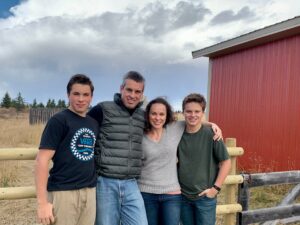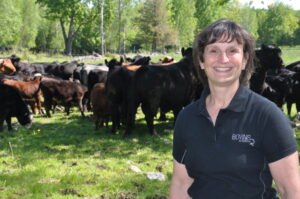Meet the Council: Flexibility and Creative Solutions Provide Opportunity for These Beef Stakeholders
The Beef Cattle Research Council (BCRC) is made up of producer members from across Canada, appointed by each of the provincial beef organizations that allocate part of the Canadian Beef Cattle Check-Off to research. The number of members from each province is proportional to the amount of provincial check-off allocated to research.
The following is part five in a series to introduce you to this group of innovative thinkers that set BCRC’s direction by sharing practices, strategies, or technologies that they have integrated into their own operations. Read part one, part two, part three and part four of this series.
Regardless of what Canadian region beef producers are from, creative marketing strategies can help farmers profit as much as possible when they sell their cattle.
Keeping Things Flexible
Lee Irvine – Alberta
Lee Irvine and his family raise cattle outside of Cochrane, Alberta. They purchased their new place just over a year ago and are still working on getting things transitioned from what was primarily a horse facility back to a working cattle operation. Their new place is 80 acres of pasture and they also have some lease land with Lee’s family that they run cattle on.
Lee works off the farm in the auction industry so having a production system that can accommodate his schedule is important. They choose the class of cattle that they run based on current markets and opportunities on their farm. This year they have been running grasser cattle.
One of the challenges Lee faced when moving to the new place was that the pasture — which includes some brush and grassland — had not been grazed in five or six years. This left a pasture where the litter was abundant and a lot of what was available was dead grass with low nutritional quality. Their goal for the first year running cattle was to get the pasture grazed down so that it could be better utilized in a rotational system in the future. This spring cattle were turned out to graze what they could as well as trample down the overgrown pastures. After adding fencing around the paddocks, Lee and his family rotated cattle through the two pastures, quickly at first and then slowed their movements through the summer as the pastures became more manageable.
When it comes to infrastructure, Lee chose free-standing panels over wood corals for flexibility and their resale ability. Lee pointed out that while permanent corals can become almost a liability when it comes to selling a place, free standing panels hold their value. Lee also chose free standing panels because it allowed for more trial and error as they set things up. “If we set up a system and notice the cows aren’t flowing through the way we want, or that they want to go out a certain corner we can just add a gate or panel to make things smoother for everyone,” he said.
Lee also likes the flexibility of a panel system. Using panels, he has the option to move where his handling facilities are located or change the whole system to suit what they are doing. It is easy to rearrange panels to build anything from a branding trap to a loading chute meaning they are not tied to doing something the way their facilities dictate.
Having a flexible attitude has been just as important as a flexible handling system. Lee points out that moving to a new place has given him the opportunity to set things up in a way that works for their family. Lee also points out that the system or class of cattle that work for them right now might not work in the future and the willingness to adopt to new ideas or opportunities is key. As they have been getting their place established, Lee has found it important to read and chat with other producers around what they are doing and what has worked or not worked for them in the past.
Increasing Producer Adoption Through Multiple Approaches
Nathalie Coté- Québec
Nathalie Coté is the ex-officio council member that represents Les Producteurs de bovins du Québec. While Nathalie is not a beef producer herself, she works closely with producers through her role as an agrologist and with the Verified Beef Production Plus (VBP+) program.
The VBP+ program is a national program that enables certified beef cattle operations to prove to consumers and retailers that their operation adheres to the highest standards for food safety, animal care and environmental stewardship.
Nathalie has played a key role in reaching a broad range of producers who have decided to participate in the VBP+ program over the past year. Nathalie says that the success of the program has been due to several new initiatives and opportunities.
The first step was that they had both a dedicated staff as well as monetary support to help build the program. Nathalie and her team were able to offer in-person workshops, individual workshops over the phone, as well as online workshops. This allowed producers to choose their method of training and provided solutions that could work for most. Being flexible with how they offered training and thinking outside the box has helped to ensure all producers could have access to training.
Working directly with producers has been key to the success of Nathalie and her team. While she points out there is value to general advertising and promotion, the real changes start taking place when they can get one-on-one with producers to discuss their individual operations. She says that when they can walk producers through sample records and what the program looks like they are better able to see how it could work on their farm. Most producers quickly see that they are already doing many of the recommended practices. Formal participation in the program was simply about keeping records on the practices they were already doing.
Another thing Nathalie says that lead to increasing engagement with producers was partnering with other groups and organizations that were already involved with producers. This allowed them to increase awareness of the VBP+ program as well as build upon already existing events to provide training or interact with producers.
The commitment of end users such as packers, supply chains and restaurants has led to increased demand for VBP+-certified beef products which has also helped drive an increase in producer uptake.
For more information on the Verified Beef Production program including if it is a good fit for your operation check out: http://www.verifiedbeef.ca/
Click here to subscribe to the BCRC Blog and receive email notifications when new content is posted.
The sharing or reprinting of BCRC Blog articles is welcome and encouraged. Please provide acknowledgement to the Beef Cattle Research Council, list the website address, www.BeefResearch.ca, and let us know you chose to share the article by emailing us at [email protected].
We welcome your questions, comments and suggestions. Contact us directly or generate public discussion by posting your thoughts below.

